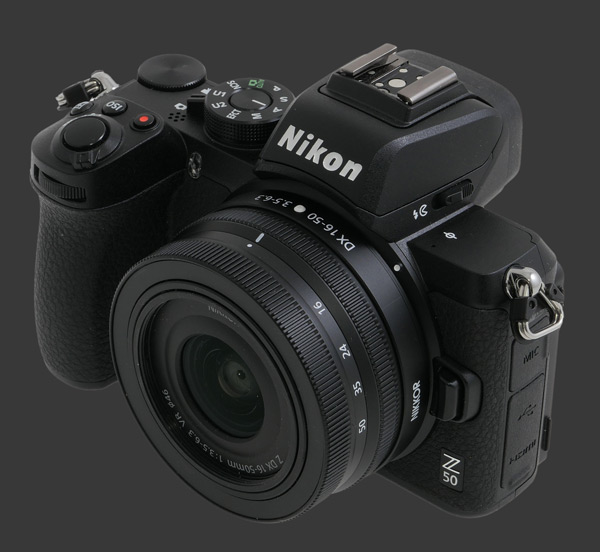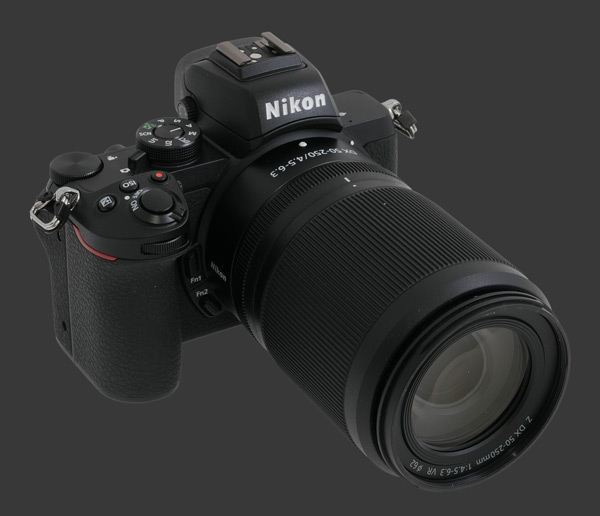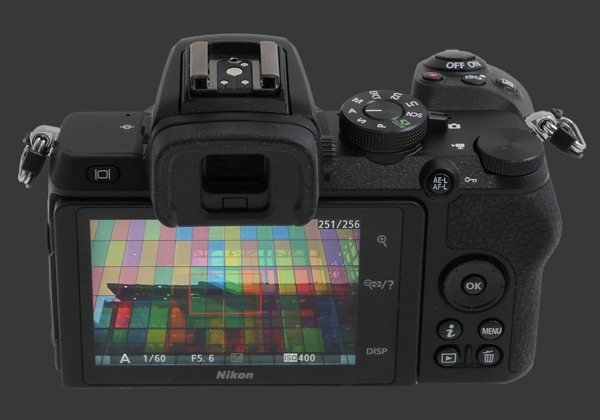Nikon Z50 Review
Nikon Z50 Introduction
Although built with the same Z-mount as Nikon Full-Frame Mirrorless Digital Cameras, the Nikon Z50 is essentially an entirely new camera. This moderately compact mirrorless is built around a 20 Megapixels APS-C BSI-CMOS sensor with an on-sensor 209-Point Phase-Detect AF system. The sensor is completely fixed and so the Z50 neither features image-stabilization nor automated sensor-cleaning, both uncommon omissions among modern mirrorless cameras.
While the wide-diameter Z-mount designed for ultra-bright optics with Full-Frame coverage is overkill for an APS-C sensor, it allows the Z50 to work with the few native lenses on the market. Naturally, Nikon launched two dedicated DX lenses for Z-mount as to realize the size-advantage of having a smaller-sensor, although the mount limits how small these APS-C cameras can be made.
The Nikon Z50 is intended for photography enthusiasts that do not want something bulky. Even smaller and lighter than the most basic APS-C DSLR, the Z50 offers a higher magnification viewfinder, dual control-dials and several customizable buttons. Its 20 MP sensor offers a wide ISO 100-204800 sensitivity range with 11 FPS continuous drive, plus 4K Ultra-HD video capability which it can assemble in-camera from its built-in Intervalometer.
As a mirorless, the Nikon Z50 generates an electronic preview to frame images. One of the differentiating factors between the high-end Full-Frame Z-series and this new APS-C mirrorless is its smaller 2.4 MP 0.39" EVF with shows 0.68X magnification with 100% coverage. This is typical for smaller mirrorless yet is significantly better than what most entry-to-intermediate DSLRs offer. Particularly, most such cameras show incomplete framing.
Nikon gave the Z50 many modern conveniences available to mirrorless cameras. This is includes a highly flexible autofocus system with realtime tracking plus WiFi, Bluetooth and a tilting LCD. This mirrorless has a single SDXC memory-card slot and is powered by a proprietary lithium-ion battery.
This in-depth digital camera review analyzes the features, ergonomics, image-quality and performance of the Nikon Z50.

Nikon Z50 Features
Sensor
- 20 Megapixels BSI-CMOS sensor
- 1.5X Crop-Factor (APS-C)
- No Anti-Alias Filter
- On-sensor Phase-Detect AF
- Standard ISO 100 - 51,200 range
- Expanded ISO 102,400 & 204,800
- Customizable Auto ISO selection
- JPEG, RAW or JPEG+RAW Output
Exposure
- PASM Exposure Modes:
- 1/4000s - 30s Mechanical Shutter
- 1/2000s - 30s EFCS
- Bulb and Timed exposure
- EC: ±5 EV, 1/2 or 1/3 EV steps
- FC: -3...+1 EV, 1/2 or 1/3 EV steps
- Matrix, Center-Weighed, Average, Spot metering & Highlight-Weighed
- AEB: 2-5 frames, max 3 EV steps, 2-9 frames, max 1 EV steps
- Exposure Fine-Tuning, ±1 EV, 1/6 EV steps
- Exposure and ISO steps of ½ or 1/3 EV
- Builtin HDR:
- 2 Frames @ 1-3 EV increments
- 3 Blending Levels
- Single image or series
Focus & Drive
- 209-Point Phase-Detect autofocus system
- Focus Drive: Single-Shot or Continuous
- Focus Selection: Pinpoint, Single, Small Wide-Area, Large Wide-Area and Auto
- 11 FPS Drive, 71 JPEG or 30 RAW
- Customizable Self-Timer, 1-9 Shots, 2-20s Start Delay, ½-3s Interval
- Exposure-Delay, 0.2-3s
- Multiple-Exposure: 2-10 shots, 4 Overlay modes
- Interval-Timer:
- 1-9999 Times, 1-9 Shots
- ½s-24h Frame Interval
- 1min-1week Start Delay
- Optional Exposure-Smoothing
- Optional Silent Photography
- Optional Interval Priority
Images Parameters
- AutomaticFour types: Normal, Remove Warm Colors Preserve Warm Colors & Natural Light, Preset, Kelvin and Custom6 Memories WB
- Preset White-Balance Fine-Tuning, 49 steps along G-M axis, 25 steps along A-B
- Kelvin White-Balance Fine-Tuning,G-M, 49 steps
- Picture Styles, 7 built-in, plus user-defined ones
- Adjustable Sharpness, 49 steps
- Adjustable Mid-Range Sharpness, 41 steps
- Adjustable Clarity, 41 steps
- Automatic or Manual Contrast, 25 steps
- Automatic or Manual Saturation, 25 steps
- Manually Adjustable Hue, 25 steps
- Manually Adjustable Brightness, 13 levels
- Virtual WB Bracketing, 2-9 frames, 3 steps, 2 axis
- Virtual Active D-Lighting Bracketing, 2 - 5 frames
- Optional High-ISO Noise Reduction, 3 levels
- Optional Long Shutter Noise Reduction
- Optional Diffraction Correction
- Optional Distortion Correction
- Optional Vignetting-Correction, 3 levels
- Optional Active D-Lighting (ADL), 4 levels or Auto
- Optional Dust-Off reference photo
- sRGB or AdobeRGB color space
Viewfinder & Displays
- 0.39" EVF
- 2.4 Megapixels
- 0.68X Magnification
- 100% Coverage
- Eye-Start Sensor
- 3.2" Tilting LCD
- 1 Megapixels
- 100% Coverage
- Touchscreen
- Dual-Axis Digital-Level
- Sound-Level monitor
Controls
- Dual control-dials
- 4-Way controller
- Traditional Mode-Dial
- Dedicated ISO button
- 2 Customizable Function buttons
- Customizable Video-Record button
- Customizable Interactive Menu
- 3 Touch Controls without physical equivalent
Body & Construction
- Nikon Z-mount
- Builtin Flash
- Standard Hot-Shoe
- Micro USB Port
- Micro HDMI Port
- Built-in Bluetooth 4.2 LE
- Built-in WiFi
- Single SDXC memory slot
- Proprietary Lithium-Ion battery
- Metal tripod mount
Video
- 3840x2160 @ 30 FPS 16:9 Ultra HD 4K
- 1920x1080 @ 120 FPS 16:9 HD
- Time Lapse Video
- 1s-10m Interval
- 1m-8h Duration
- Optional Exposure-Smoothing
- Optional Silent Photography
- Optional Interval Priority
- MPEG-4 or Quicktime H.264 codec
- Flicker Reduction, 60Hz, 50Hz or Auto
- Optional Audio:
- Built-In Stereo Microphone, 20 levels
- Wide or Vocal Frequency Response
- Optional Wind Noise Reduction
- Optional Attenuator
- Stereo input mini-jack
Nikon Z50 Capability - What can it do?
For their first APS-C mirrorless, Nikon created the Z50 as an intermediate-level model with core features between the D5xxx and D7xxx series of DSLRs, while also including many that are exclusive to mirrorless cameras. Of course, the most important feature of the Nikon Z50 is its compact-size and lightweight body. Its inclusion of advanced functionality and good number of controls makes it lean towards photographers that are ready to experiment with photography and the new Z-mount platform.
The heart of the Z50 is a 20 megapixels BSI-CMOS sensor with wide sensitivity range and a 209-Point Phase-Detect AF system built right in. The sensor omits a low-pass filter to maximize the amount of detail it captures. One omission though is the lack of a automatic sensor-cleaning system. This makes the Z50 quite prone to dust which can be cleaned manually but this fact could make beginners uncomfortable. In fact, the sensor does not move at all since the Z50 also omits image-stabilization. The industry is still split on its inclusion yet manufacturers are leaning towards in-body stabilization.

One clear advantage of mirrorless cameras is speed. The Nikon Z50 can shoot continuously at 11 FPS for 71 JPEG images or 30 RAW files. Among DSLRs, this level of performance is only available in high-end models because the mechanics of a reflex mirror are much more demanding. The hybrid shutter of the Z50 is capable of working mechanically at maximum speed, although the front-curtain is usually electronic to minimize vibrations. To further reduce shake, Nikon offers a customizable Shutter-Delay from 0.2 to 3 seconds. There is an option in the Configuration menu to force a completely mechanical shutter yet it always appeared disabled on our review unit. A completely silent electronic shutter is also available.
Exposure latitude on the Nikon Z50 is quite standard. The mechanical shutter operates from 1/4000 to 30s with a maximum 1/2000s when using EFCS. Longer Bulb and Time exposures are also possible to capture light trails. The standard sensitivity range of the 20 MP BSI-CMOS sensor in this mirrorless starts at ISO 100 and reaches 51,200. This is expandable 2 stops further until ISO 204,800. While this makes the Z50 more sensitive than most APS-C cameras, faster shutter-speeds are available on modern mirrorless which evens things out.
Nikon provides the most sophisticated Interval Timer modes, including in the new Z50. One can select and interval from ½s to a full day with up to 9999 intervals. Between 1 and 9 images can be captured at each interval and the process can start up to 1 week later! Allowing multiple frames per intervals makes it possible to create HDR Timelapse using AEB. The Interval Timer can be customized with:
- Exposure Smoothing - Dampens changes in exposure between shots. This reduces Automatic Exposure changes between shots to smooth transitions.
- Silent Photography - Forces the use of the electronic shutter to reduce noise from the camera. For some undocumented reason, one cannot combine Silent Shooting together with multiple frames per interval.
- Interval Priority - This decides whether the interval or the shutter-speed has priority. When Interval Priority is On, images are always taken at the given interval, even if more time is required for the exposure.
- Starting Storage Folder - Allows the sequence of images produced to be stored in a folder separately from other images and videos.
There is a separate Time Lapse feature that creates a 4K Ultra-HD or Full 1080p video from a automatically captured images, played back at 24-30 FPS for 4K and up to 60 FPS for Full-HD. It supports an interval from 1s to 10m for up to 8 hours. Intelligently, this digital camera warns in advance if sufficient memory is not available.
Four metering patterns are available on this mirrorless: Matrix, Highlight Weighed, Center-Weighed/Average and Spot. Highlight Weighed, combines multiple segment readings to preserve highlights. Average or Center-Weighed metering depends on an option in the Customization menu that selects between average or a 8mm central metering circle.
Auto-Exposure Bracketing can be enabled for 2 to 9 frames with steps up to ±3 EV when taking 5 frames or less. One can bracket exposure parameters, flash or both. Virtual Bracketing for WB or Adaptive D-Lighting can be performed instead with 3 step sizes for WB and 5 for ADL. In both cases, only one photo is taken but it is rendered multiple times. For obvious reasons, Virtual Bracketing only applies to JPEG.

Realizing the nuances and difficulties of Auto White-Balance, Nikon offers 4 variants on the Z50: Neutral White, Natural White, Warmth Preserving and Natural Light Balancing, although Nikon does not name them so distinctly. There are 6 presets With 7 sub-types for Fluorescent: Sodium-Vapor, Warm-White, White, Cool-White, Day-White, Daylight, High Temperature Mercury Vapor.. Custom WB now has 6 memories. Each nicely shows a thumbnail of the image from which it was recorded. A small selectable area can be sampled. Kelvin WB can be selected between 2500K and 10000K. WB Fine-Tuning offers two axis except for Kelvin which only supports the G-M axis. Regardless, there are always 49 steps along G-M and 25 along B-A. The temperature span along each axis is actually the same, only Nikon allows twice as fine increments along one axis.
This camera features Nikon's Active D-Lighting image processing technology which lightens up dark areas of images to bring out details. There are 5 levels of ADL which differ by how much shadows get boosted. ADL can be manually or automatically set to one of those levels or turned off entirely. Active D-Lighting indirectly affects RAW capture because exposure is adjusted according to the selected level.
Along with this APS-C mirrorless, Nikon launched two dedicated DX lenses that emphasize compactness above all else. These two lenses are dim variable aperture zooms with a collapsible design. Together these span a focal-range of 16-250mm which is equivalent to 24-375mm in a full-frame. The Z50 natively supports the handful of already existing Z-mount lenses plus most Nikon AF-S lenses via an optional adapter.
 |
Please Support Neocamera
All information on Neocamera is provided free of charge yet running this website is a huge endeavor. Purchases made via affiliate links found throughout the site help keep it running and up-to-date. There is no additional cost to you, so please consider buying via these links to our affilates:
If you found any information on this site valuable and did not purchase via our affiliate links, please considering donating via PayPal:
Any amount will be greatly appreaciated. Thank you for your support!
Nikon Z50 Highlights

Sensor-Size: 24 x 16mm

Actual size when viewed at 100 DPI
| 20 Megapixels Mirrorless | ISO 100-204800 |
| Nikon Z Mount 1.5X FLM | Shutter 1/4000-30s |
| 0.39" Built-in EVF 2.4 Megapixels (0.68X) | Full manual controls, including Manual Focus |
| Automatic Eye-Start sensor | Custom white-balance with 2 axis fine-tuning |
| 1 Axis Digital Level | Spot-Metering |
| 11 FPS Drive, 71 Images | Hot-Shoe |
| 3840x2160 @ 30 FPS Video Recording | Stereo audio input |
| 3.2" LCD 1 Megapixels | Lithium-Ion Battery |
| Secure Digital Extended Capacity |
Updates
2025.01.18

Fujifilm GFX 2025 Lens Roundup
Lens Review roundup of Fujifilm GFX Medium-Format lenses. Quality, performance and handling of the GF20-35mm F/4R WR, GF30mm F/3.5 Tilt-Shift and the GF55mm F/1.7.
2024.11.18

Best 2024 Photography Gifts for Every Budget
Great gifts for photographers and photo enthusiasts selected for every budget among the best products of 2024.
2024.08.07

Eye Protection Tips for Professional Photographers
The four main considerations for professional photographers regarding eyewear.
2024.07.14

Fujifilm X100VI Review
Flagship fixed-lens compact digital camera with a 40 MP sensor and Image-Stabilization, a first for the series. Retro design featuring dual control-dials, plus direct ISO, Shutter-Speed and EC dials. Its hybrid viewfinder can switch between EVF and OVF mode.
2024.05.09

Fujifilm GFX100 II Review
Flagship 102 Megapixels Medium-Format Mirrorless Digital Camera with 8-Stop 5-Axis IBIS, 8 FPS Drive, 8K Video and 400 MP Super-Resolution capture in a weatherproof and freezeproof body with dual control-dials and dual memory-card slots.
2024.04.03

Fujifilm X-T5 Review
Newest Fujifilm flagship boasting a 40 MP APS-C sensor, 5-axis IBIS with 7-stop efficiency, 15 FPS continuous drive, 6.2K Video capture, dual control-dials and dual SDXC UHS-II slots in a sturdy weatherproof and freezeproof body.
2023.11.20

Best Digital Cameras of 2023
Find out which are the Best Digital Cameras of 2023. All the new Mirrorless Digital Cameras from entry-level to high-end professional.
2023.07.10

Fujifilm X-H2 Review
40 Megapixels APS-C Hybrid Mirrorless Digital Camera with 7-stop IBIS. Fastest shutter ever and 8K video capture. Large builtin EVF with 0.8X magnification and 5.8 MP, plus an Eye-Start Sensor. Packed with features and large number of controls in a weatherproof and freezeproof body.
2023.05.07

Sony FE 20-70mm F/4G Review
Review of the unique Sony FE 20-70mm F/4G lens. The optical zoom of this lens spans ultra-wide-angle and medium focal-length coverage, making it one of the most versatile Full-Frame lenses on the market.
2023.01.15

Huion Inspiroy Dial 2 Review
Review of the Huion Inspiroy Dial 2 tablet, a medium sized drawing surface with dual dials and customizable buttons. Connects via USB-C or Bluetooth 5.0 with Windows, Linux and Android support.
2022.12.08

How to Pack for a Photo Trip
Find out how to pack for a travel photography trip, carry your gear safely while meeting airline regulations.
2022.11.13

Best Digital Cameras of 2022
The best digital cameras of 2022. A short list of the most outstanding models in their respective categories. Choose one for yourself or as a gift.













